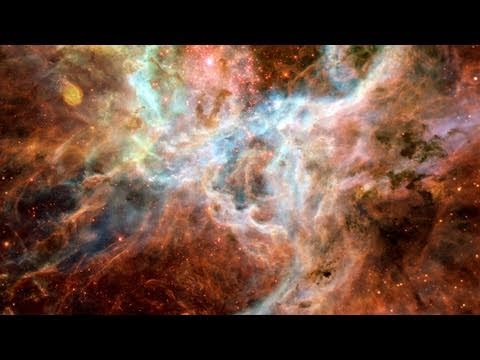From Hubblecast, the famed Tarantula Nebula explored in a detailed new image from the Hubble Space Telescope. The Large Magellanic Cloud, or LMC, is a small companion galaxy of our own Milky Way. It can be seen with the naked eye, as a faint grey blotch in the constellation of Dorado.
It’s a favorite hunting ground for astronomers and it has been studied by many telescopes. Its most dramatic feature is the Tarantula Nebula, a bright region of glowing gas and energetic star formation. Hubble has produced a close-up view of this nebula, which reveals this dynamic region of our Universe in unprecedented detail.
This part of the Tarantula Nebula is one of its most dynamic, showing the area around the supernova remnant NGC 2060. These wispy tendrils of dust and gas are the only visible remnant of a star which has exploded.
After puffing out these smoky remains, the core of the star that formed NGC 2060 collapsed into a pulsar, which is a type of neutron star. The Tarantula nebula glows brightly because the atoms in its hydrogen gas are excited by the bright, newborn stars that have recently formed here.
These toddler-stars shine forth with intense ultraviolet radiation that ionizes the gas, making it light up red and green. The light is so intense that although around 170 000 light-years distant, and outside the Milky Way, the Tarantula Nebula is nevertheless visible without a telescope on a dark night to Earth-bound observers.
But the biggest and brightest stars in the Tarantula are actually just outside Hubble’s field of view. This wider, but less detailed view of the Tarantula Nebula was taken with the MPG/ESO 2.2-metre telescope, at La Silla Observatory in Chile. It shows the source of much of the Tarantula’s light: the super star cluster RMC 136.
So it wasn’t in fact that long ago that astronomers were still debating whether this intense light came from a compact star cluster, or perhaps an unknown kind of super-star. It’s only been in the past 20 years that we have been able to prove that it is indeed a star cluster – albeit one that hosts some of the most massive stars that have ever been observed.
The Tarantula Nebula also hosts the supernova 1987a. Now, of all the supernovae that have been observed since the invention of the telescope, this one is by far the closest to us. Pulling further back, the size of the Tarantula Nebula relative to its host galaxy becomes clear. It is the brightest known star forming region in the local Universe and one of the most attractive spots in the night sky.

